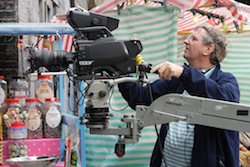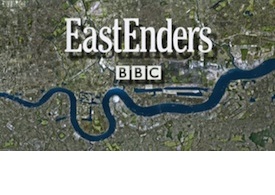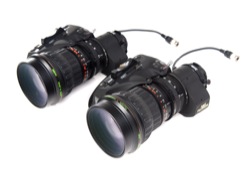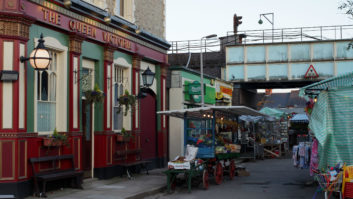
The BBC aspires to transfer all production over to HD by 2012 and has a rolling period of investment to re-equip its studios. Currently the focus is on the Elstree home of Eastenders in preparation for an HD broadcast this Christmas, as Adrian Pennington reports.
According to Danny Popkin, BBC Studios and Post Production’s technical development manager, the decision was brought forward because the end of the facility’s natural cycle was in sight. “It was driven less from a desire to go HD internally at the BBC but from the need for a periodical technology refresh — but staying SD wasn’t really a viable option,” he says.
Eastenders is the last of the major UK soaps to get the HD treatment. Hollyoaks switched first, transmitting in June 2008 closely followed by Emmerdale. In May this year ITV1 HD aired the first HD episodes of Coronation Street.
In mid-2009 the Corporation was discussing uprooting production of its biggest show from Elstree and relocating to Pinewood, where new HD-compatible sets could be built from scratch. As this idea was shelved the technical considerations for maintaining and revamping Elstree crystalised.
“When Studios and Post Production secured the contract to make Eastenders at Elstree for the next five years it gave us the green light to examine production requirements and begin procurement based on existing infrastructure rather than undergoing a complete rebuild,” says Popkin. “Fundamentally with a continuing drama series like Eastenders we are striving for high production values in the most efficient way in the studio, on the lot and on location. This is best achieved using multi camera shooting techniques.
Previously footage was captured from the studio direct to Avids for editing offline quality and a DVCPRO 50 tape conform before final SD delivery. Popkin wanted to establish a new fully tapeless workflow, where efficiencies could be gained from no digitising or linear conform, and reduction of grading time — which meant sourcing a common camera type and recording online and offline quality across lot, studio and location.
“We needed to take advantage of the fact that we’d already laid triax cable throughout the Elstree site,” he says. “We looked at the HDC 1500 with triax adaptors but because we’d be taking a digital signal into an analogue device we wouldn’t quite achieve the required 1920 pixels. The edges of the picture would ramp up and down, a normal occurrence when moving from analogue to digital, but one we knew wouldn’t pass the stringent BBC Technical Review tests for pre-recorded programmes.”
With Panasonic not fielding a systems camera in the UK, Popkin turned to Sony’s HSC-300 digital triax based models. Following extensive trials and testing, to see if they could break the digital compression system, the combination of the HSC-300 and PDW-700 XDCAM HD422 camcorders were selected. The XDCAM’s were for location work and both models benefited from being able to use the same 2/3” CCD sensor, and common accessories, along with new Fujinon HA13, 22 and 23x lenses.
“The picture quality has had a visible improvement in quality,” says Popkin. Fujinon also provided new digital small shotboxes which allow easy recall of pre-set lens angles — a vital tool to give repeatability of shots during rehearsals.
Eastenders is the first full-scale application of Ingex, the BBC-developed open-source software that captures to a variety of formats and removes the need to digitise footage. It will also be the first to record multistreams to Ingex in HD (Avid DNxHD at 120Mbps). In the studio and lot the cameras are individually recorded onto the Ingex, along with the ‘cut’ information from the vision. Material is logged at the point of capture, potentially enabling quicker and more integrated workflows.
“The recorders have a local cache and between recordings the material is transferred to the main networked storage of 88 TB,” explains Popkin. “We offline directly from that (at 10:1) but online and finish the programme from a 32TB Unity. The online pictures are re-linked to the Ingex storage and consolidated onto the Avid Unity. Previously we digitised entire tapes at offline quality and then had to do a conform to get online quality pictures.
“The Ingex recorder creates both online and offline quality simultaneously in the studio gallery. The location rushes are imported from the XDCAM discs at online quality. We then work with mixed resolutions on the timeline, so in essence we’ve cut the digitising time right out of the workflow.”
CRTs and LCDs
Five Media Composer Nitris perform most of the editing work which sees four half hour blocks recorded a week. On average one episode a day is sound mixed on two new ProTools suites working to the offline version on Unity. Final delivery is on HDCAM SRW with all rushes backed up to LTO tape and archived for about a year. Technical review is also carried out on site, including a Harding test.
System integration is by Dega Broadcast Systems, which has worked on the outfit of Eastenders’ SD installations a decade ago. It deployed a SIS Live OB truck as a replacement for one of three galleries to maintain production in SD while each gallery is upgraded.
“Eastenders production is spread across three galleries which can control any one of five shooting spaces,” explains Popkin. “There’s a common radio talkback system covering the entire site so we can work to any of the galleries, or integrate the truck as a replacement.”
The refurbishment process involved removal of all the SD equipment, monitor stacks and wiring, and then refitting of new Evertz routers, Trilogy SPG’s with GPS locking, new monitor stacks and conversion equipment from Crystal Vision. Each gallery took two weeks to strip and refit.
“The biggest challenge was the timescale and trying to do the conversion without delaying the show’s production one iota. We can’t afford to lose any time because the production schedule is too tight. That meant a lot of liaising with Dega and the production team about the best way to proceed.” Unexpected issues, such as cable damage by mice added to the challenge.
Monitoring in all the galleries is on a mixture of CRT and LCD monitors from JVC, Ikegami and Sony, with Sony LCD’s chosen for the floor monitors.
“The black balance and resolution of LCD is not good enough and may never be good enough to fully replace CRT’s, in a control gallery where the viewing angle is not perfect, especially for drama work where most of the camera ‘look’ decisions are made in the studio and not in a grade,” he says.
Location monitoring is on a mixture of Sony LCD and TVLogic OLED. The studios also have received new fluorescent lighting, replacing the ageing high energy tungstens.
“Tungsten may be more powerful but this is countered by the new generation of cameras which are more sensitive to light by two stops,” says Popkin.
The sets themselves won’t be immediately replaced, although a major storyline development will enable some of them to be rebuilt for HD shooting. “We don’t need to change as much as you’d think,” says Popkin. “We’re looking after the sets and storage of them with greater care. Generally we’d like to put some backgrounds a bit more out of focus to give a sense of space but it’s hard to change the layout with longstanding sets.
“It is important to ensure that there are large enough monitors to see any focus issues; when the cameras are working at f2.8 or less, the depth of field is sometimes less than the depth of the subject’s head. It is a very skilled camera operator who can hold focus in these situations, especially when the largest viewfinder available is an 11” OLED, and many home screens are 50” plus.”






